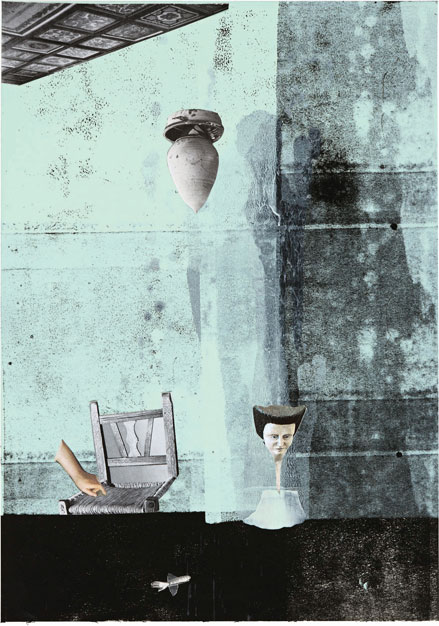Gert and Uwe Tobias are no ordinary artists. Identical twins born in Romania 40 years ago, they work together to create vivid, large-scale woodcuts that are as haunting as they are alluring. Twisted faces, dismembered pieces of furniture, hearts, flowers, lizards, human eyes and staring owl heads are intermingled with old-fashioned typewriter lettering to create imagery that, while drawing from European Romanticism, Transylvanian folklore and even the geometry of the Bauhaus, invents a world all of its own – dense, dreamlike and undeniably beautiful.
These days the twins – tall, athletic and with the sort of looks that wouldn’t be out of place on a Milanese catwalk – are based in a studio complex in Cologne. There, in a suite of Rationalist buildings, they have their studio, their homes, their parent’s home and a gym – they work out for at least an hour a day. They started collaborating in 2001, after years of trying hard not to. “We wouldn’t work together if there wasn’t a point,” says Uwe, the elder by five minutes. “But the trust we have as brothers to give and take criticism really enables our work to progress.” Gert concurs: “Creativity requires friction and antagonism, and we both have loud voices,” he laughs, “but the building is still standing.”
In recent years, the international art world has been increasingly taken by their work – a dramatic large-scale collage had pride of place in the booth of their New York gallery, Team, at Art Basel Miami Beach last December – and collectors are queuing up to buy pieces, among them Hilary Weston, the wife of Canadian billionaire Galen. (The Westons own the upmarket department stores Holt Renfrew in Canada and Selfridges in London, among other assets.) Nice work, chaps.
Your address: The St. Regis Bal Harbour Resort
Image of Gert and Uwe Tobias by Corbis
Untitled 2012
“The starting point for this piece is chinoiserie, and the composition is like that of a tapestry,” says Gert, who with his brother was inspired by exquisite 18th-century chinoiserie prints they discovered in Dresden’s Kupferstich-Kabinett – a museum specializing in prints and drawings. But while the imagery of tapestry is traditionally that of hearts, flowers and delightful woodland animals, in the artists’ hands darker elements, such as skulls and strange creatures, appear in their place. “The colour invites you into the picture,” Gert says. “Then we try to unsettle the decorative appeal by introducing the spikes and thorns.”
Untitled 2012
The Tobiases say that it’s simply a lucky coincidence, allied with their immense curiosity, that led them to work with print and woodcuts. “We have redefined woodblocks,” Uwe says. “In a traditional German woodcut you can see the artist’s hand, how he has carved the piece, as well as the grain of the wood. We use a cut-out form that then takes the ink.” In their carefully calibrated collages, the twins don’t aim to tell a story but to present a range of images that, they say, “the imagination of the beholder can work into their own narrative.” Images, such as the spindle on the right (above) are reminiscent of fairytales. The owl – all seeing and all knowing – is a favoured creature in their world.
Untitled 2012
There is a dark humor in the artists’ dislocated collages. Heads are often shaved into cone-shaped forms; legless chairs float across the canvas. “Humor is a means of analysis, rather than a joke,” Gert says. “It moves the work away from its origins in folklore and Romanticism, and breaks with tradition.” The twins work on pieces individually, but begin each new project with drawings that form the basis for discussion. “All decisions are shared,” Uwe says. “And the exciting thing is that the sum of our working together is so much bigger than the two parts. We’re not a cliché of symbiotic twins, though in terms of taste and interest, we have a lot of common ground.”
Untitled 2012
You won’t find many primary colors in the Tobias brothers’ work. Their palette is one of cloudy pastels and worn-away blacks. These color choices, as well as their love of collage, connects them art-historically with the Surrealists, as do the strangely composed creatures, floating faces and dismembered pieces of furniture that dance across their canvases. “There should be a moment of familiarity on initial contact, in that first moment when you look at a piece of work,” they say. The next stage, of course, is when the beholder realises that all is not as it seems. Photography, for example, brings a sense of reality, that’s quickly cancelled out by a bewildering array of disparate details.
Untitled 2012
The pair use the dainty letters of the traditional mechanical typewriter, like so many tiny cross-stitches, to punctuate their canvases and create silhouettes of animals or skulls, for example. “The typewriter letters present a set of limitations, but they come with a very particular atmosphere of their own,” Uwe says. “They’re visually pretty,” Gert continues, “and they have a historic quality. We are aware of our historicity.” Embroidery and needlework are recurring themes in their work: for the twins, they are a symbol of historic tradition as well as an evocation of the humble, emotional human quality of handicraft, and a reminder of their old life in Transylvania.








